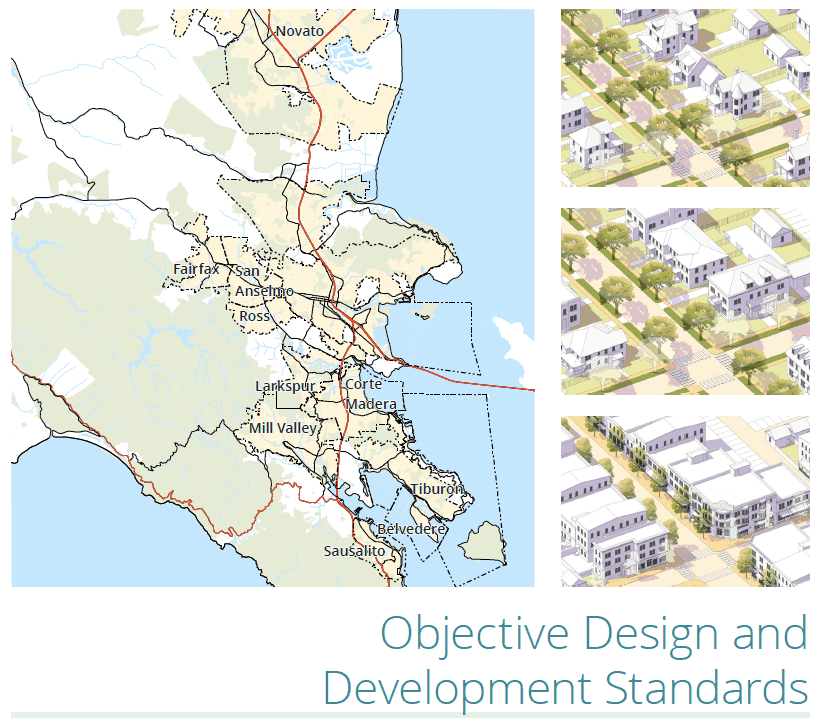
News
By Jamie Zouras, December 15, 2022

The Form-Based Codes Institute (FBCI) at Smart Growth America is thrilled to announce the winner of the 16th annual FBCI Form-Based Code Award. The award jury selected Opticos Design for their Objective Design and Development Standards in Marin County, California for achievement in the writing and implementation of a stellar model form-based zoning code.
Opticos Design, Inc. collaborated with Marin County to create a Toolkit of Objective Design and Development Standards to serve as an integrated catalog of standards calibrated to the Marin County environment, providing a variety of zoning tools based on a palette of eight zone districts to deliver context-sensitive design standards for multifamily and mixed-use residential development across Marin County’s 520 square miles of diverse towns and cities.
On January 19 at 3:00 p.m. Eastern, FBCI is hosted a webinar to hear about lessons learned from representatives from the team who drafted the winning code, regional planning experts, and the jurisdictions who have, or are in the process of implementing the model code.
In contrast to a typical model ordinance approach that needs to be general enough to be relevant to all jurisdictions but often is so general that it comes across as unresponsive to local needs, Opticos applied a place-based approach to create standards that recognize key physical characteristics or the ‘DNA’ that make up each of the jurisdictions. This is especially important because many of the potential sites for new housing are in non-neighborhood contexts (e.g., commercial corridors, industrial areas, shopping mall transformations) that need policy direction on which zone(s) to apply. The toolkit provides standards that are relevant to each city and town, allowing each jurisdiction to select only the content they want to adopt or further customize to their community’s unique needs.
“The County of Marin and its participating jurisdictions worked collaboratively to create a form-based code that encourages much needed housing development and complies with state regulations. The toolkit was the result of careful analysis of over 700 sites in the County that had potential for multi-family housing development and detailed studies of existing placetypes that demonstrated good urban design. Ultimately, jurisdictions will use these standards to create form-based codes that streamline the development process.”
—Jillian Zeiger, AICP, Senior Planner, County of Marin

Noteworthy elements
“This model code exemplifies the differentiating strengths of form-based codes: clear guidance for better design outcomes and predictable, fair, and timely review processes,” Peter Park, Director of Peter J. Park, LLC and Chair of the 2022 FBCI Award Jury, explains. “While conventional codes, coupled with onerous discretionary review procedures, create barriers to delivering affordable housing in a timely manner, Marin County’s Objective Design and Development Standards provides an exemplary model for jurisdictions and communities to overcome complicated use and density rules through clear form and design standards.”

A noteworthy contribution of this work is the transferability and adaptability of the code adoption process to not only Marin County jurisdictions but also large and small communities across California and beyond. The standards allow for creative freedom by focusing on basic objective design elements that address how buildings relate to the environment, to other buildings, and to the public realm. This innovative and design-forward open-source toolkit provides a clear path for California communities to implement state mandates; confidently move away from time-consuming review processes; facilitate greater housing capacity and diversity; and achieve higher design quality outcomes.
A regional approach to form-based coding

The Objective Design and Development Standards is also an exemplary model of multi-jurisdictional cooperation. By pooling their financial resources, Marin County communities have created a shared form-based coding platform that aligns regulatory language across the county and provides more accessible, fair, and transparent ways for guiding development. The toolkit provides a menu of calibrated standards (especially helpful for communities with limited institutional capacity) with options for further customization through place-based approaches. For example, Chapter 8 of the code—Specific to Large Sites—masterfully describes how to create walkable neighborhoods through calibration of basic urban design elements such as blocks, streets, and buildings for various site scales and contexts.
The Marin County model form-based code and its exemplary inter-jurisdictional approach provide promising new ways for regions across the U.S. to cut through restrictive regulations and complicated approval processes that limit housing supply and increase housing costs.
Congratulations to this year’s winner!
Join us on January 19 at 3:00 p.m. EST to hear about lessons learned from representatives from the team who drafted the winning code, regional planning experts, and the jurisdictions who have, or are in the process of implementing the model code.
Related News

© 2025 Smart Growth America. All rights reserved
Site By3Lane Marketing










